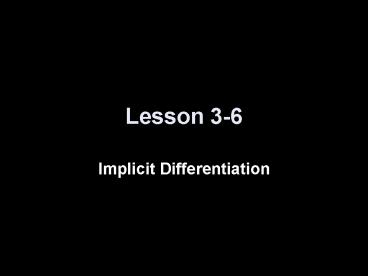Implicit Differentiation PowerPoint PPT Presentation
1 / 11
Title: Implicit Differentiation
1
Lesson 3-6
- Implicit Differentiation
2
Objectives
- Use implicit differentiation to solve for dy/dx
in given equations - Use inverse trig rules to find the derivatives of
inverse trig functions
3
Vocabulary
- Implicit Differentiation differentiating both
sides of an equation with respect to one variable
and then solving for the other variable prime
(derivative with respect to the first variable) - Orthogonal curves are orthogonal if their
tangent lines are perpendicular at each point of
intersection - Orthogonal trajectories are families of curves
that are orthogonal to every curve in the other
family (lots of applications in physics (example
lines of force and lines of constant potential in
electricity)
4
Implicit Differentiation
If a function (or a relation) can not be set into
the for y f(x), then implicit differentiation
(differentiating both sides with respect to x and
solving for y) can be used to find the
derivative. Example (a circle with radius 10,
which is a relation and not a function) x² y²
100 dx dy
dy 2x ---
2y ---- 0 ? 2x 2y ---- 0
dx dx
dx
dy dy -x
2x -2y ---- ? ----
-----
dx dx y
5
Implicit Differentiation
Example (a circle with radius 10, which is a
relation, not a function) x² y² 100 If we
tried solving for y first in the above circle we
would get the following y v100 - x²
this gives us two functions y v100 - x² and
y -v100 - x²
Differentiating the first (upper semi-circle)
of these would give us dy
-2x
-x -x ---- ½ (100 - x²)-½
(-2x) ----------------- --------------
-------- dx
2v100 - x² v100 - x²
y solving for the second one (lower
semi-circle) again gives us the same answer
because y is negative for all values in it.
6
Guidelines for Implicit Differentiation
- Differentiate both sides of the equation with
respect to x. - Collect all terms involving dy/dx on one side of
the equation and move all other terms to the
other side. - Factor dy/dx out of the terms on the one side.
- Solve for dy/dx by dividing both sides of the
equation by the factored term.
7
Example 1
Find the derivatives of the following
1. y³ 7y x³ 2. 4x²y 3y x³ 1
3y² (dy/dx) 7(dy/dx) 3x² dy/dx(3y² 7)
3x² dy/dx 3x² / (3y² 7)
8xy 4x² (dy/dx) - 3(dy/dx) 3x² dy/dx(4x² -
3) 3x² - 8xy dy/dx (3x² - 8xy) / (4x² - 3)
8
Example 2
Find the derivatives of the following
3. x² 5y³ x 9 4. Find Dty if
t³ t²y 10y4 0
2x 15y²(dy/dx) 1 dy/dx(15y²) 1 2x dy/dx
( 1 2x) / (15y²)
3t² 2ty t²(dy/dx) 40y³(dy/dx) 0 dy/dx(t²
- 40y³) 3t² 2ty dy/dx (3t² 2ty) / (t² -
40y³)
9
Example 3
Find the derivatives of the following
y 1 1/3(x 0)
5. Find the equation of the tangent line to the
curve y³ xy² cos(xy) 2 at x
0. 6. Find dy/dx at (2,1) if 2x²y
4y³ 4.
y³ - (0)y² cos(0) 2 ? y³ 1 y
1 3y²(dy/dx) y² - 2xy(dy/dx) sin(xy)
(xdy/dx y) 0 dy/dx(3y² - 2xy xsin(xy))
y² ysin(xy) dy/dx (y² ysin(xy)) / (3y² -
2xy xsin(xy)) (1)/ (3) 1/3
2x²(dy/dx) 4xy 12y² (dy/dx) 0 dy/dx(2x²
12y²) -4xy dy/dx (-4xy) / (2x² 12y²)
(-4(2)(1)) / (22² 12(1)) -8/20
10
Example 4
Find the equation of the normal line (line
perpendicular to the tangent line) to the curve
8(x² y²)² 100(x² y²) at the point (3,1).
8(x² y²)² 100(x² - y²) 16(x² y²) (2x
2y(dy/dx)) 200x 200y (dy/dx) 32x³ 32xy²
32x²y(dy/dx) 32y³(dy/dx) 200x
200y(dy/dx) (dy/dx)(32x²y 32y³ 200y) 200x
32x³ - 32xy² dy/dx (200x 32x³ - 32xy²) /
(32x²y 32y³ 200y) dy/dx (600 32(27)
32(3)) / (32(9) 32 200) -9/13 Normal line
slope, -1/mt 13/9 y 1 (13/9)(x
3)
11
Summary Homework
- Summary
- Use implicit differentiation when equation cant
be solved for y f(x) - Derivatives of inverse trig functions do not
involve trig functions - Homework
- pg 233-235 1, 6, 7, 11, 17, 25, 41, 47

